#sequential hermaphrodite
Explore tagged Tumblr posts
Text
By: Frederick R. Prete
Published: Mar 1, 2024
A few weeks ago, I wrote a piece that appeared on the Substack, Reality’s Last Stand. My intent was to compliment and complement Dr. Wright’s critique of Ian Copeland’s (erroneous) claim that biological sex (which is different from “gender”) is non-binary. Copeland’s somewhat tired arguments were based on a misunderstanding of genetic aneuploidies (errors in chromosome number), and poorly reasoned analogies to the fact that some fish change sex over the course of their lives. I’d like to revisit and expand a few of my points here.
As usual, Wright’s analysis was thoughtful and accurate. However, I wondered out loud how much of this long-suffering debate is shorn up by repeated attempts to engage in it with evermore biologically detailed counter arguments — a thankless task in which I, too, have participated. Although I have the utmost respect for those with the patience to remain in the argumentative fray, I don’t think reason will ever change what is, in effect, an ideological point of view. But, again, I admire those who try.
As I said in the piece, we need to recognize that some arguments are just wrong. So wrong, in fact, that a reasoned rebuttal is not only futile but beside the point. In those instances, we should be honest. I know from decades of teaching that sometimes I have to say to a student — always in a kind and respectful way — that while I appreciate their point of view, it is simply mistaken… It doesn’t jibe with anything that I know about the natural world. In such instances, this is the most honest and effective response, and it allows the discussion to be reset on a more reasonable foundation.
To be clear, even very smart, well-meaning people come up with far-fetched ideas born out of fundamental misunderstandings, or ignorance about a particular topic. (That would be the case, for instance, if I tried to diagnose what’s wrong with your car, a topic about which I know absolutely nothing.) In these instances, it makes little sense to debate the erroneous argument and then rebut the person’s attempts to support their misconceptions with additional unfounded speculations (often ad infinitum). So, if I claim that an animal’s sex is determined by radio waves beamed down from the planet Zenon by unicorns, it would be a waste of your time to explain to me that unicorns couldn’t make radio transmitters with their little hoofs, or that Zenon (wherever it is) is too far away to communicate with us earthlings. If you did offer up this rebuttal, I’d simply come up with some counter argument about unicorn dexterity or the superior strength of unicorn radio technology. That would be a total waste of our time. At some level, I suppose, it’s also disingenuous to pretend that the unicorn argument merits a reasoned response. I think it would be more honest (and effective) just to dismiss the unicorn theory out of hand rather than fueling — and thereby giving credence to — an unending back-and-forth.
That’s how I feel about the recurring claims that disorders of sexual development (DSDs), or genetic aneuploidies represent unique sexes. Frankly, these claims are so discordant with the realities of biology that they will never be refuted successfully by logic, reason, or data. To argue that biological anomalies represent unique sex categories makes no more sense than claiming a syndrome such as CDC (which can result in penile duplication) gives rise to ‘new types’ of men. These arguments are simply wrong. End of conversation.
And, please, just ignore those ridiculous — but supposedly instructive — analogies to animals. Let’s be honest. Animals do a lot of weird things. They enslave other animals, eat their offspring, cannibalize their lovers, kill their newborn twin sisters, and devour their siblings in the womb. Does anyone want to justify slavery or sibling cannibalism because animals do it?
And, how about those strange animal mating behaviors? Consider the male argonaut (a genus of octopus). He grows a sperm carrying third left arm in a pouch under his eye which — when he’s ready for love — explodes out of its sheath, detaches from his face, swims away all by itself, latches onto a female, and then wriggles its way into her mantle cavity to drop off a packet of sperm. Do you think we humans should invent a face-mounted, free-flying phallus to enhance our love-life? After all, it works for the argonaut. (By the way, I don’t think you should add that suggestion to your online dating profile.)
Well, If a free-flying phallus doesn’t seem like a good idea, why would anyone think that the sexual behaviors of other aquatic animals — like sex-changing clown fish — reveal some profound philosophical insights into the human condition?
Even more exasperating is the fact that the people who keep harping on sex-changing fish never get the story straight. The truth is that the sex changes that occur in about 20 families and seven orders of fish are the result of neuro-physiological and hormonal events triggered — depending upon the species — by ultimate body size, perceived social status, or (in the monogamous clown fish, Amphiprioninae) after the big breeding female has disappeared. In addition, the large, dominant, newly-minted female is viciously aggressive to any fish outside of her immediate family. So, if we’re taking our cues from clown fish, let’s not be hypocrites. Let’s go all the way: Only really large, domineering, hyper-monogamous humans who are particularly xenophobic should consider changing sex, but only after all the females in the neighborhood disappear. Does that even make sense? (You know I’m being facetious, right?) It’s a silly analogy. Is it worth debating?
In the previous essay, I also brought up an obvious (but consistently ignored) point of fact: Fish live in the water. People live on land. This makes all the difference in the world when it comes to sex. If you live in water, you can spray your eggs and sperm (gametes) into the liquid environment and let them drift around until they hook up. That’s because, in water, they won’t dry out and die. And, neither will the resulting embryos because they’ll be in the water, too. That’s why some fish can produce eggs or sperm at different times in their lives. It doesn’t take any special external body parts to squirt gametes into water. All you need is a gonad to make the gametes and an orifice to let them out.
However, if you’re a terrestrial mammal (living on dry land), you have a problem. You can’t squirt your gametes on the ground and hope for the best. They’ll shrivel up and die. So, male terrestrial animals evolved special external body parts with which to insert sperm directly into females (where it’s warm and moist), and females evolved body parts designed to accept that protuberance. In addition, female mammals (except for a few monotremes) evolved a chamber in which to hold the developing embryo until it’s ready to face a potentially desiccating life on land. Equally important, both males and females evolved complementary behavioral patterns that allow them to court and mate successfully. Frankly, it doesn’t make any difference if you’ve got the external body parts but you don’t know how to use them. (Get my drift?)
That’s why terrestrial mammals can’t change sex like fish. Doing so would require females to magically sprout some kind of tube to deliver sperm internally, and males would have to spontaneously develop a complementary orifice. In addition — and more importantly — males and females would have to develop all the necessary internal ‘plumbing’ and mating behaviors necessary to operate their new equipment. So, a mammalian sex change requires more than altering the external structures. That’s the easy part. It can be done surgically, even on your pets.
Becoming a male terrestrial animal would require developing a complex duct system linking the gonads to that new, external tube, and internal glands to secrete a carrying fluid and nutrients for the sperm (i.e., the Wolffian duct system, prostate, and bulbourethral glands). Becoming a female would require developing some kind of internal tube that would catch the eggs when they’re released into the abdominal cavity, hold them until they meet some sperm, and house the developing embryo (i.e., the derivatives of the Müllerian duct system).
Obviously, none of this could happen. When it comes to mammals, the die is cast prenatally. In other words, whatever fish do is their business. It has no grand implications for terrestrial mammals. So, let’s drop the clown fish and Asian sheepshead wrasse analogies. Anybody who brings them up simply doesn’t understand evolutionary or developmental biology. It’s not worth the debate unless, of course, you’re one of those people who thinks that because some animals are parthenogenic, we should simply stop having sex altogether and hope for the best.
I also want to clear up two more points. The first is sort of minor. It has to do with the large gamete/small gamete dichotomy between male and female animals: Females produce large gametes; males produce small gametes. This is frequently cited as evidence that there are just two sexes, easily differentiated by gamete size. Although generally true, I want to point out (yet again) that there are always exceptions in biology. Unfortunately, those exceptions are often the fuel that ignites these recalcitrant debates about sex when someone ‘discovers’ the exception and then claims it to be a new, profound revelation upending all prior knowledge. The odd exception to which I’m referring here is the colossal size of the fruit fly sperm. You probably didn’t know — few people do — that the tiny fruit fly, Drosophila bifurca, produces sperm that are 58 mm (~2.25 inches) long. That’s about 20 times longer than its entire body and over 300 times longer than a female’s egg is wide. In fact, these sperm are thought to be the longest sperm of any animal on the planet. So, I’m sure that at some point, someone will use this fact to argue against the large gamete/small gamete dichotomy between the sexes. It will be a silly argument, of course. I just want you to be forewarned.
The second point has to do with reptile sex determination. I have heard this phenomenon described inaccurately by people on both sides of the sex binary debate. It comes up almost as frequently as the clown fish analogy. Frankly, it’s a bit misleading to the lay reader to say that turtle (or alligator) sex is ‘determined’ by temperature. Although this is the common way it’s phrased in the biological literature, it should be made clear that sexual development in reptiles and amphibians is a product of the same types of genetic and physiological processes that operate in other animals. Saying that reptile sex is ‘determined’ by temperature makes it sound like the whole process is much more capricious than it is. While “a narrow range of incubation temperatures during a thermosensitive period of embryonic development” can affect the underlying genetic, physiological, and biochemical processes in ways that alter the sex ratios (i.e., the relative numbers of males and females) in a cohort, the most proximate causes leading to a turtle or alligator being male or female are physiological. In the end, it’s all genes, hormones, and molecules just like it is in other animals. And, the ultimate developmental outcome is binary.
The take-home message
So, here’s the upshot: You should just be you… and I’ll just be Frederick. We don’t need to ask flies, fish, or turtles for permission to be what we are, or what we hope to be… they’ve got their own problems to deal with. Capisci?
Epilogue
As I said in the previous essay, I have a deep understanding of, and great compassion for those people — which includes me — who don’t match the accepted stereotypes of any particular category or group. Over the years, I have been the target of what seemed to be an unrelenting stream of criticism for the fact that I was never (and still am not) perceived as representative of the norm (whatever that is). Consequently, I grew up defending those who were similarly targeted, and I believe that each of us should be continually mindful and accepting of the rich diversity of the human condition. Each of us should actively and consciously strive to be as compassionate, accepting, supportive and inclusive as we can. Denigrating, harassing or bullying anyone for any reason is reprehensible and unacceptable as far as I am concerned.
However, being open, kind, and accepting does not necessitate abandoning reason, turning our backs on biology, or unhinging ourselves from reality. Nor does it require us to entertain the arguments of those who do.
#Frederick Prete#Frederick R. Prete#reproduction#biological sex#sex is binary#sex binary#gametes#biological reproduction#human reproduction#gender pseudoscience#hermaphroditism#sequential hermaphrodite#sequential hermaphroditism#clown fish#religion is a mental illness
4 notes
·
View notes
Text
Wet Beast Wednesday: California Sheephead Wrasse
A lot of people through history and the modern day have an overly simplistic view about sex, both in the sense of biological sex (that is, what gametes something produces) and sex as in the act of mating. A lot of people think that sex is just a strict binary between males and females, but nature is far more diverse and varied than that (even in humans. Intersex people do exist after all). Today I'm showcasing one of the animals that completely goes against the alleged sex binary: the California Sheephead Wrasse. And yes, this is a pride post.
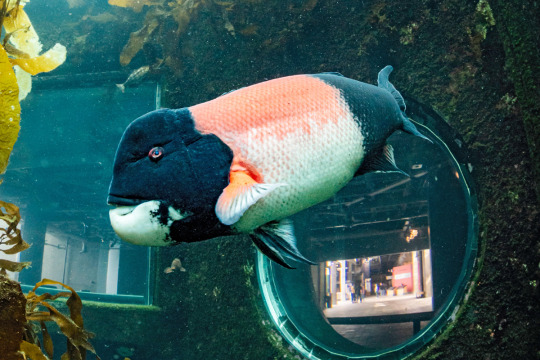
(Image: a male California Sheephead Wrasse in a tank in the Monterey Bay Aquarium. It is a large fish with a bulbous head. The head and tail are black, midsection is pink, and the belly and chin are white. End ID)
The California Sheephead (Semicossyphus pulcher) is a large fish in the Wrasse family of Labridae. They are sexually dimorphic, with the males and females appearing distinct from each other in size, shape, and color. Males are larger than females, reaching up to 91 cm (3 ft) and 16 kg (35 lbs), though there is quite a bit of size variation based on food availability. They have flatter faces than females thanks to a bulbous bump on the forehead. This lump is the namesake of the fish, since it allegedly make it look like it has a sheep's head. I personally don't see it at all. Males have black heads and tails with a white chin and underbelly and pink midsection Females are smaller and colored silvery to a dull pink all over except for their white chins and underbellies. There isn't really a maximum size or weight for females for reasons I'll get into later. The fish have large canine teeth that protrude from the mouth and modified throat bones that form a grinding apparatus called the throat plate.
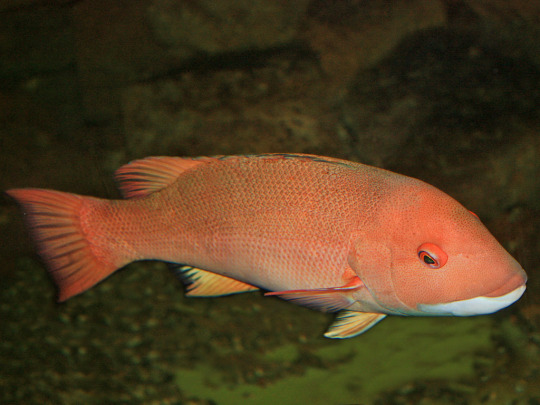
(Image: a female California Sheephead. It has a less bulbous head than the male and is a pale pink all over, except for the white belly and chin. End ID)
Sheepheads, like many wrasses, are sequential hermaphrodites. A sequential hermaphrodite can transition between sexes during its life (as opposed to a simultaneous hermaphrodite, who can produce both sperm and eggs at the same time). Every California Sheephead is born female and some will become male later in life, making them protogynous. Protogyny is the most common form of hermaphroditism in fish, with over 75% of known sequentially hermaphroditic fish species being protogynous. This transition is a one-way process, males will not turn back into females. The transition is triggered by a number of factors, primarily size and the local availability of males. If there are not enough males in the area, the largest female will transition to male to fill the role. This transition takes between 2 weeks and a few months depending on availability of food and other conditions (temperature seems to play a role) and the fish will be capable of producing sperm before fully assuming the male morphology.
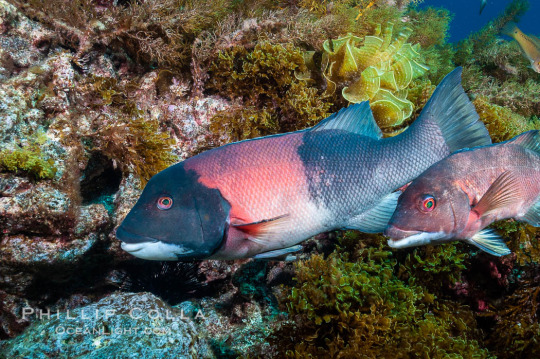
(Image a male and female Sheephead swimming next to each other. The female is roughly half the size of the male. End ID)
During mating season (July-September), males will pick a territory and claim all nearby females as mates. A younger male without a territory may challenge an alpha male to try to claim his territory. These fights are often resolved with threat posturing, but if neither male backs down, they will fight with biting and raking teeth against the opponent. During mating season, females will release batches of 375,000 eggs almost daily for males to fertilize. During this time, the alpha male will patrol his territory to mate as much as possible while chasing off smaller males who may attempt to sneakily fertilize some of his female's eggs. The larvae are planktonic for their first 34-78 days, and will sink as they grow. Juveniles have a different coloration to the adults. They are orange, with a white stripe running down the body and dark spots on the fins. The average maximum age of a California Sheephead is 21 years, but the oldest individual on record was 53 at the time of capture.
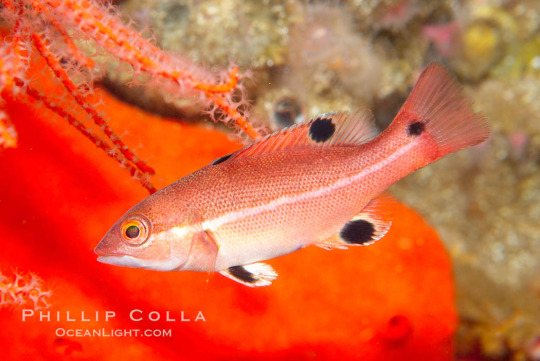
(Image: a juvenile Sheephead. It is a small, orange fish with a white stripe running from eye to tail and black spots on the pelvic, anal, dorsal, and tail fins. End ID)
The California Sheephead lives on rocky reefs and kelp forests from southern California to the Baja peninsula and Gulf of California. They prefer shallow water between 3 and 30 meters (10 - 100 ft) deep, though males will occasionally venture deeper. Sheepheads are predators that hunt hard-bodies invertebrates including urchins, shelled molluscs, and crabs. Juveniles hunt smaller prey such as sponges, bryozoans, and barnacles. The protruding canines give the fish a better grip when trying to pry food off of rocks. They crush the hard shells of the prey with sharp teeth before swallowing. The shells are then further ground down by the throat plates. Smaller individuals have been known to break open urchins too large to bit by picking them up and hammering them into rocks. Sheepheads play an important role in kelp forest ecosystems by keeping urchin populations down. Urchins eat kelp and without predators keeping their numbers in check, can reduce kelp forests to urchin barrens. Sheepheads are known to have a high site fidelity, meaning they will return to the same places over and over. They will maintains a sleeping spot (usually a crevice they can hide in or rock they can hide under) and return to the same places to hunt. They are diurnal and return to their sleeping spots at night to avoid predators.

(Image: a male Sheephead trying to pick up a sea urchin with tis mouth. End ID)
California Sheephead Wrasses are classified as vulnerable to extinction by the IUCN. Their primary threat is overfishing. The Sheepheads have been commercially fished since the 1800s and their numbers have dropped. The hermaphroditic nature of the species actually makes things worse. Commercial fishers are incentivized to catch the largest fish and the largest Sheepheads are the males and females that are likely to transition to male. Unlike with other species, there aren't small males around to make up for the loss of large males to fishing since the small fish are the females. The loss of males and the largest females (who are the ones most likely to transition to male) means there aren't enough males around during mating season to keep the population high enough. The introduction of marine protected areas and fishing regulations have helped the population recover. The loss of the Sheepheads is a big deal since they're one of the species doing the most to keep the kelp forests healthy by eating urchins. Natural predators of the Sheepheads include sharks, sea lions, and giant sea bass.

(Image: a fisherman holding a male Sheephead on a boat. The large canines of the fish are particularly visible. End ID)
#wet beast wednesday#transmasc icons#california sheephead wrasse#sheephead wrasse#wrasse#fish#fishblr#fishposting#pride#hermaphrodite#sequential hermaphroditism#protogyny#marine biology#biology#zoology#ecology#animal facts#educational#informative#image described
102 notes
·
View notes
Note
what's the most trans animal
Hoo, boy, that’s a bunch to choose from…!
Certain frogs have been known to switch sex with no signs of pollution in their environment (no Alex Jones “They’re turning the frogs gay!” nonsense, frogs can just do that sometimes).
There’s also clownfish, where a big female has a harem of males and if the female is removed then the biggest male becomes a female.
Based on my (admittedly limited) knowledge of the subject, I’d have to pick Wrasse. Wrasse are a group of saltwater fish that includes a lot of different species (you may have heard of Cleaner wrasse), and under certain conditions big females switch to males, small males switch to females, or those fish may decide to just stay as they are. In one laboratory test, a female became a male, then transformed back when researchers placed it in a different tank with another male! Wrasse don’t care what your pastor or the US Government think.
Any other fish biologist blogs out there feel free to chime in!
15 notes
·
View notes
Text
webfishing is a very cute game but sometimes it feels suspiciously "bro is gender neutral, my guy" about certain things
#I dressed up a cartoon cat and gave myself gender dysphoria do you know how hard that is to do#the problem is that unfortunately a lot of the time 'neutral' does read masc in that kind of character design space#and there's generally not a lot of feminine character customization options#so like it's hard not to make a bean that reads as pretty butch at best#and then you got like the king title but no queen no clever joke about clownfish being sequential hermaphrodites#what are we doing here#it's apparently pretty early on in development so hopefully they remember to add women later#hopefully.
12 notes
·
View notes
Text
thinking about. canon trans ally olimar

#Rambles Into The Void#'but this is about sequential hermaphroditism that's not-' listen to me. it's not about that part.#it's about the surprise then the 'well no. i should've considered that a possibility' and the 'who am I to say what's weird?'#acceptance of the unfamiliar yknow?
37 notes
·
View notes
Text
fighting for my life on reddit talking about parthenogenesis and sequential hermaphroditism
#Emu tries to post#good god#someone has come into the conversation saying#HEY THATS NOT TRUE INTERSEX FISH CAN REPRODUCE ASEXUALLY#my sudden acquaintance . That word does not mean what you think it means#I was saying that I've never heard a case of an intersex fish/aquatic invert yet#and that anyway no intersex individual would be able to reproduce with both sets of organs#because someone brought it up (about betta fish reproducing asexually?) and I had to explain what it actually means#and now I have to explain to this guy that intersex and hermaphrodite are two very different things and you have gotten them badly mixed ip#also fighting for my life when people try to tell me ramshorns reproduce with self fertilisation#THEY DONT.#somehow I'm becoming a semi expert on the topic of snail reproduction#and because people get confused I also have to know about sequential hermaphroditism#which at least there is no aquatic snail doing that#idk what land snails do#everyone is always like: all snails are one sex and reproduce asexually!!1!111#nooooooo#even the few species of aquatic hermaphrodite still mostly need partners#only 2 species actually reproduce asexually. And one of them is gonochoric#well technically parthenogenesis doesn't count as asexual apparently??#but for the purposes of me talking about which snails reproduce without sex they do count
7 notes
·
View notes
Text
Happy Pride to queer role models, fish, and the whole slew of other organisms that do this.
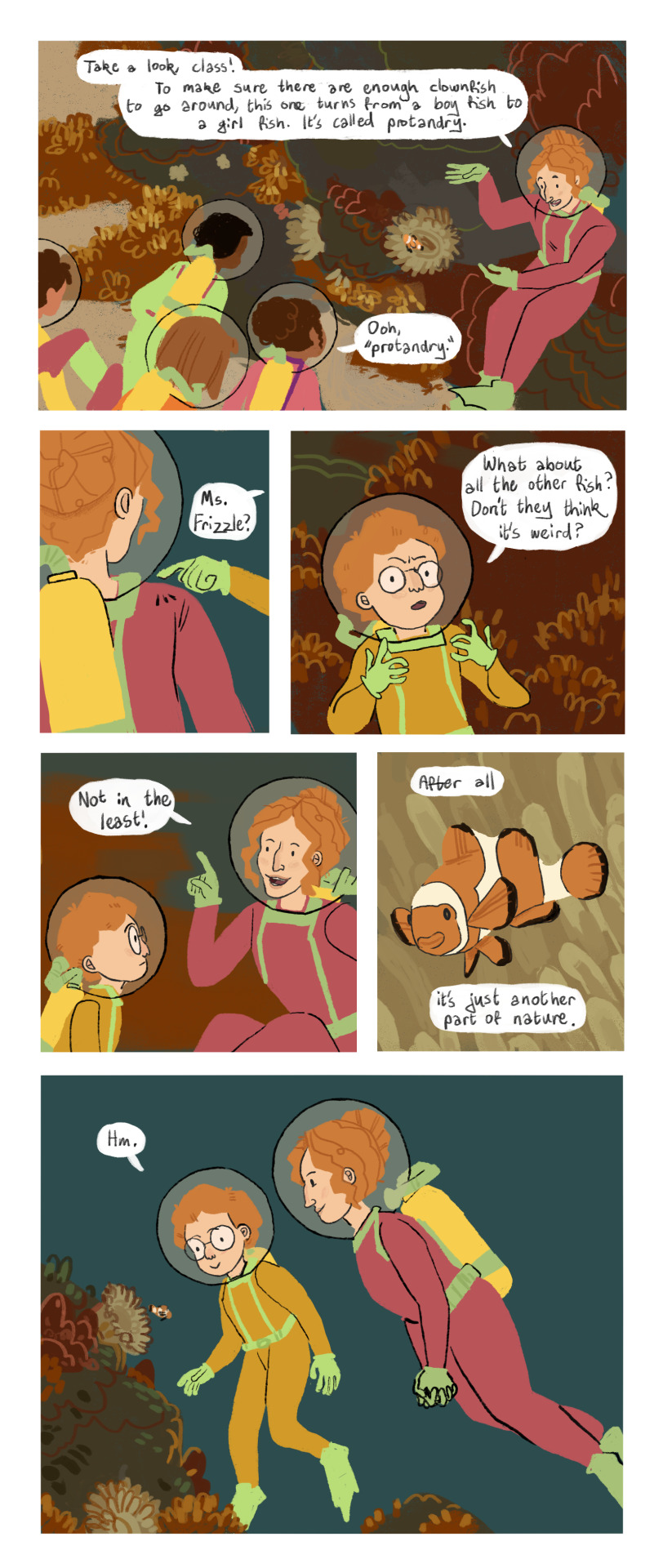
happy pride to queer role models and fish
#transgender#The Magic School Bus#artwork#comic#fanart#nature#clownfish#marine life#marine biology#protandry#sequential hermaphroditism#LGBTQ+#LGBTQ Pride Month#fish#Ms. Valerie Frizzle#Arnold Perlstein#there I said something
116K notes
·
View notes
Text

By: Frederick R. Prete
Published: Feb 11, 2024
About the Author
Frederick Prete is a biopsychologist in the Dept. of Biology at Northeastern Illinois University. He teaches courses in neurobiology, and human and animal physiology. He has also served as an associate editor for the International Journal of Comparative Psychology. Prete writes about how people use and misuse biology to support their social and political points of view.
Other essays by Prete can be found on his Substack Everything Is Biology.
--
The contemporary “debate” (if one can call it that) surrounding the biology of sex suffers from a lack of intellectual seriousness on one side. The arguments forwarded by those insisting on the non-binary nature of sex often demonstrate a rudimentary understanding of basic biology, or are so comically nonsensical that one wonders whether they’re even worth responding to. Academic biologists engaging with gender activists’ arguments for the so-called “sex spectrum” are like mathematicians engaging with numerologists (individuals who believe in a mystical relationship between numbers and coinciding events) or geologists debating Flat Earthers. However, given that sex pseudoscience has somehow taken over academia, serious scholars now find themselves compelled to engage with the absurd.
One such example is the bizarre suggestion that because some fish can literally change sex during their lifetime, then perhaps humans can too. This idea, while absurd on its face, is far from fringe. It has been given credence by popular science outlets like Scientific American, which highlighted the sex-changing abilities of clown fish “to emphasize the diversity of ways in which sexual beings move through the world.” Even the United Kingdom’s national library posted (and later deleted) a thread on X during Pride Month last year about the sex-changing abilities of the Māori wrasse, and Greenpeace made a similar move in 2021.
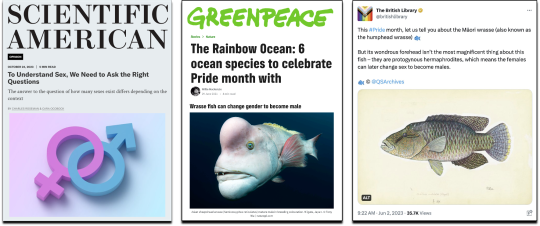
What relevance does LGBTQ+ Pride Month have to sex-changing fish unless there’s an intention to suggest that these examples illuminate the potential for sex changes in humans? But if activists insist on making such far-fetched comparisons, they should be challenged to follow their logic to its ultimate conclusion.
Let’s be honest, animals do a lot of weird things. They enslave other animals, eat their offspring, cannibalize their lovers, kill their newborn twin sisters, and devour their siblings in the womb. Do any of these activists want to justify slavery or embryonic cannibalism because animals do it? Probably not. But it’s equally silly to claim that we can derive grand lessons about human biology and sexual behavior from animals. Male octopuses, for instance, grab a packet of their own sperm with one of their tentacles, shove inside a female’s mantle cavity, and drop it next to her oviduct. This hardly seems like a behavior humans should try to emulate. Are there any objections? Why, then, would we think that fish sexual biology is a better model for us humans than that of octopuses?
What’s more, it frustrates me that those who continuously discuss sex changes in fish don’t get the fish-sex story straight in the first place. In reality, sex changes among the roughly 20 families and seven orders of teleost fish are driven by physiological and hormonal events that are triggered—depending on the species—by factors such as body size, perceived social status, or (in the monogamous clown fish Amphiprioninae) the disappearance of the large, breeding female. It’s also the case that those big, newly minted, dominant female clown fish are viciously aggressive to any fish they do not recognize as part of their group. So, if we’re taking our cues from clown fish, let’s not be hypocritical—let’s go all the way and demand that only extremely large, dominant, hyper-monogamous people who are particularly xenophobic should consider a sex change, and only after all the other females in the neighborhood have vanished. Does that sound reasonable? (I trust you realize I am being facetious here)
It should go without saying, but it appears that some still need a reminder: people are not fish. Fish live in the water. People live on land. When it comes to sex and reproduction, this makes all the difference in the world. In aquatic environments, you can simply release your gametes (eggs and sperm) into the water and let them drift around until they hook up. That’s because, in water, they won’t dry out and die. And neither will your embryos because they’ll be in the water, too. This is why so many fish can produce eggs or sperm at different times in their lives. It doesn’t take any specialized external organs to squirt gametes into the water, just a gonad for gamete production and an orifice for release.
However, the whole situation changes if you live on dry land. As mammals evolved for terrestrial life, they had to acquire adaptations—both structural and behavioral—to prevent their gametes and embryos from drying out. You can’t simply drop your sperms and eggs on the ground and hope for the best. So, male terrestrial animals evolved specialized external body parts for transferring sperm directly into females, who, in turn, have evolved body parts designed for receiving sperm and a chamber for nurturing the developing embryo until it is ready for life on dry land. Additionally—and equally important—both males and females evolved complementary neuromuscular behavioral patterns that allow them to court and mate successfully.
That’s why terrestrial mammals can’t change sex like some fish do. Such a transformation would require females to spontaneously sprout some kind of tube for internal sperm delivery, and males would need to somehow develop a complementary orifice. Moreover—and more importantly—both males and females would need to develop all the necessary internal parts and “plumbing” to make these external structures functional. It’s insufficient to merely alter the appearance of external structures, which can be done surgically (even on pets). A terrestrial animal transitioning from a female to a male would also require developing a complex duct system linking the gonads to the external tube, along with glands to secrete a carrying fluid and nutrients for the sperm (i.e., the Wolffian duct system, prostate, and bulbourethral glands). Going from male to female would involve developing some kind of organ to catch the eggs when they get released into the abdominal cavity, retain them until they encounter sperm, and then house the resulting embryo while it develops (these are derivatives of the Müllerian duct system).
Obviously, none of this could happen. When it comes to mammals, the die is cast prenatally. So, whatever fish do is their business and has absolutely nothing to do with terrestrial mammals. So, let’s drop the clown fish and Asian sheepshead wrasse analogies. Anybody who brings them up simply doesn’t understand evolutionary biology. It is futile to engage in discussions based on such analogies unless, of course, you’re one of those people who think that because some animals reproduce parthenogenically, humans should simply stop having sex altogether and hope for the best.
I want to make it clear that I have a deep understanding and empathy for those of us, including myself, who do not fit the popular stereotypes of any category or group. Throughout my life, I have received what seems to be an unrelenting stream of criticism for the fact that I was never (and still am not) perceived as representative of the norm (whatever that is). Consequently, I grew up defending those who were similarly targeted, and I believe that each of us should be continually mindful and accepting of the rich diversity of the human condition. Each of us should actively and consciously strive to be as compassionate, accepting, supportive, and inclusive as possible.
However, doing so does not require us to abandon reason, turn our backs on biology, or unhinge ourselves from reality.
#Frederick R. Prete#Frederick R Prete#people are not fish#sequential hermaphroditism#sex change#clownfish#human biology#human reproduction#evolutionary biology#reproduction#biology#biology lesson#gender ideology#queer theory#gender identity ideology#science#religion is a mental illness
15 notes
·
View notes
Text
Gonosimulistic- it's a better scientific replacement for "hermaphrodite". Use it. It's better and more accurate, and the only bad part is that we haven't bothered to codify or list the derived forms.
For a while, I was resigned to using "hermaphrodite" because I'm a biologist, and we will always need some way to describe animals like slugs or clownfish that aren't gonochoric.
I have been enlightened. Thank you, @ders1tes for showing me a better path- my argument towards the use of "hermaphrodite" was never that it isn't a slur, it's that we needed something for animals in a scientific context, and "intersex" was firmly centred on humans or at most, gonochoric vertebrates.
Anyway:
Gonosimulistic: Adjective form. "Slugs are a textbook example of a gonosimulistic species."
Gonosimulist: Singular noun form. "This slug is a gonosimulist."
Gonosimulists: Plural noun form. "Many slugs are gonosimulists."
Sequential gonosimulist: A species that changes sexes over its lifespan.
Simultaneous gonosimulist: A species that produces both male and female gametes.
1K notes
·
View notes
Text
It’s a biological fact that fish do indeed change their sex to keep the male/female ratio balanced in their school population.
Some fish do exhibit bidirectional sequential hermaphroditism. From what I found, it seems unclear just how much this occurs in nature, though it does occur at least in some cases there as well as in captivity. I didn't see any sources specifically claiming that it was used to keep an even sex ratio (but I only did a few brief searches and skimmed a few papers) Fish do all kinds of different strategies when it comes to sex. Some do an age based M -> F. Some do age based F -> M. Some can go back and forth depending on environmental factors. Some depend on local social structure, like some clownfish were there is one big female and her several smaller males, if she dies, one of the males gets bigger and becomes female.
Most fish are just male or just female their whole life more like what we mammals are used to.
I don't know offhand of any fish that are simultaneously male and female (producing viable sperm and eggs in the same general period of time), but maybe there are and I just haven't heard of them. Ah here is at least one case: "Evidence for Hermaphroditism in the Squalius alburnoides Allopolyploid Fish Complex"
Totally fair to base merfolk off of the idea of balancing the sex ratio, BTW, not saying otherwise! But want to be clear that that exact thing may not be known in fish, and if present, is part of a great variety of fish sex strategies.
Some of the interesting papers I saw in my brief searches: Hermaphroditism in fish: incidence, distribution and associations with abiotic environmental factors
Bidirectional Sex Change in Seven Species of Priolepis (Actinopterygii: Gobiidae)
Bidirectional Sex Change in Marine Fishes
and some other info:
https://en.wikipedia.org/wiki/Sequential_hermaphroditism
https://evolution.berkeley.edu/fisheye-view-tree-of-life/gender-bending-fish/
https://karger.com/sxd/article/10/5-6/223/296444/Bending-Genders-The-Biology-of-Natural-Sex-Change
tired: mermaids are all women
wired: much like elves, merfolk are mistaken by sailors for being all women because they have long hair and are very pretty
232K notes
·
View notes
Text
Fucking, thank god for grad students. Grad students are truly the GOAT of science. A lot of scientific research is limited by what kinds of research can produce results that might be profitable for businesses, including the journals that publish that research in the first place. But grad students? They're not trying to make money for anyone, they're trying to prove themselves as scientists before entering the professional world. The only thing a master's or doctorate thesis is supposed to do is prove to your university that you have mastered your craft and are capable of producing research that meets the standards of the scientific community. The only job that a graduate student has when producing that thesis is to do good research that has never been done before. They're just about the only scientists whose sole prerogative is to look where no one else has looked to answer questions that no one else has, possibly because no one else has even asked them yet, and to compile their results, whatever they are, for the pure sake of knowledge itself.
I'm not a scientist, I'm just someone who does scientific research in my free time because I'm deranged enough to think it's genuinely fun, and because a lot of the art I do is scientifically informed. But because I'm doing this research for art rather than a more "practical" application, a lot of the times the reasons why I want to know something are completely different from the reasons why these topics are actually studied. I don't want to know how to create synthetic equivalents of Feline Facial Pheromone F3, whose function we already know, in order to reduce stress and prevent undesirable behavior in pet cats in new homes and vet clinics, I want an analysis of the components that make up Feline Facial Pheromones F1 and F5, whose functions we don't know, in order to start building hypotheses about what those functions might be, so that I can figure out how catgirls would perceive these pheromones and theorize how they might talk about them in their native languages. But nobody's gonna pay me to do that, are they?
And let me tell you, sometimes the only people who seem interested in the kinds of bizarre and esoteric questions that an artist like me will have are grad students publishing theses. I still haven't found anyone trying to figure out what FFP F1 or F5 are used for, but I have found:
A full, comprehensive description of the complete phonology and grammar of the Lushootseed language and its dialects, spoken by several Coast Salish tribes of the Puget Sound region, published by Ted Kye in 2023 for his doctoral thesis at the University of Washington. Lushootseed is the source of many words from the region, including hugely important place names like Snoqualmie, Muckleshoot, Puyallup, Snohomish, Sammamish, Duwamish, Mukilteo, Shilshole, and of course, Seattle, but the language itself is extinct, with its last native speaker, Vi Hilbert, dying in 2008. There are, however, efforts to revive the language, and that would be significantly more difficult without Ted Kye's work. I think we can all see why this kind of thing is valuable.
And, this second one is a bit more esoteric but hear me out:
The discovery that a popular ornamental aquarium fish might actually have been sequentially hermaphroditic this whole time, which was practically a footnote in a 2016 thesis by Lia Gomes and Silva Henriques from the University of Porto, in Portugal. The fish in question is the red-tailed shark, Epalzeorhynchos bicolor, which is not an actual shark, but a member of the carp family that just happens to look like a shark, and two very important things to note about it are that it is critically endangered in the wild, and in fact was thought to be totally extinct in the wild until one was found in 2014, and that they are also practically impossible to breed in captivity. The primary threat to the species is considered to be habitat destruction. The quite substantial supply of this species in the pet trade today all come from fish farms in Southeast Asia, which use hormones to induce reproduction in the species, through processes that are kept as trade secrets and are essentially unknown to the scientific community. So, we have literally no idea how this fish breeds, which means that hobbyists can't breed it themselves, and scientists don't know what conditions they even need in order to breed in the wild. This one paper, written by students in Portugal who attempted to induce gonadal maturation in the species using hormone injections, is perhaps one of the only clues we have on the path to saving this species, and it hints at a conclusion that could have HUGE implications for the husbandry, captive breeding, and survival in the wild of the red-tailed shark: all of the individuals that were dissected without having undergone hormone injections were immature females, and immature males only started appearing in groups that had been injected, suggesting that all individuals of the species might start out as females, and then at some point in their development, certain individuals, for unknown reasons, may develop into males instead, making them sequential hermaphrodites. This isn't unknown in fish (clownfish do something similar, except they all start out as males and become female when they achieve dominance in their social group), but it was completely unexpected in this species, and could go a long way in starting to explain the difficulties with breeding them and potentially be a step on the path to learning how to breed them in captivity, as well as saving them in the wild.
Unfortunately, in the latter case, I wasn't able to find any other published work by either of the listed authors, and no one else seems to have repeated the experiment. This is a real shame, because the results of the experiments, while very intriguing, weren't conclusive; they had a fairly low sample size, and would need to be confirmed by further research. But there's no indication of that research being done, and I might be the only one other than the university's board of reviewers who's even read the thing.
All this is to say, fish testicles are interesting and I'm begging someone to do more research on them, please.
870 notes
·
View notes
Text
what if elves were sequential hermaphrodites that are born male but blossom into beautiful milfs as they reach a certain age. a whole species of gayboys and older tgirls. like parrotfish
273 notes
·
View notes
Text
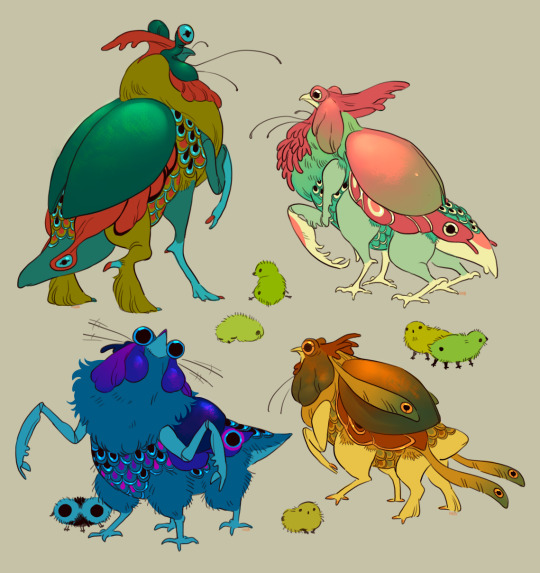
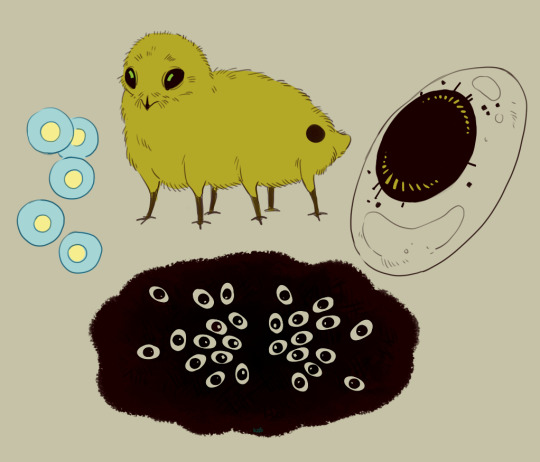
Pillyki redesigns~
i have granted them extra pinch abilities.
top pic is some common island breeds with their Piips (larvae). got a standard Lush, a Coral, a Berry, and a Mossy. bottom pic is life cycle from egg to cocoon.
fun facts:
when frightened a Piip's feathery fluff shifts into patches of black that make it resemble two large unblinking eyes when seen sideways.
they can shoot paralyzing venom from the sacks near their eyes. this venom is sometimes harvested for medical reasons but it must be watered down to be used safely.
wild Pillies spin their cocoons in pits lined with ashes from dead hawks. the glow of the cocoons make it look like a many eyed creature is staring out from the pit.
most Pillies resemble what we would consider roosters and it's very difficult to determine what sex a Pilly is. even if you think you're sure, your "buck" pilly might start laying eggs out of the blue one day. sequential hermaphrodites? mistaken identity? who knows.
3K notes
·
View notes
Text
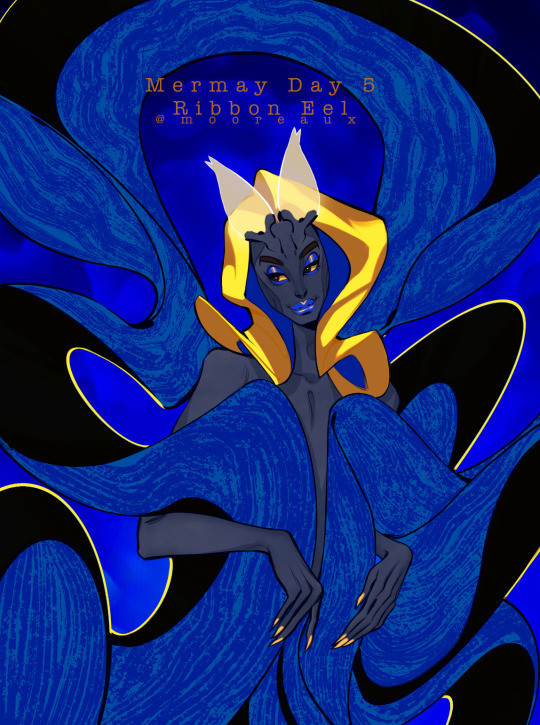
Mermay Day 5: Ribbon Eel
The ribbon eel is a mesmerizing Indo-Pacific species known for its dramatic transformation: born as jet-black juveniles, they mature into electric-blue males and finally become golden-yellow females, a rare journey of sequential hermaphroditism unique among moray eels. Dwelling in sandy burrows near coral reefs, these slender eels spend most of their lives hidden, with only their vibrant heads protruding to ambush prey. Their beauty and unusual life cycle make them a diver’s delight, but their survival depends on remaining in the wild, as they rarely thrive in captivity.
395 notes
·
View notes
Text
*carcar watching Finding Nemo*
Oscar: clownfishes are sequential hermaphrodites..and with the absence of the mother, Marvin had no other option but to find his son so they could breed for continuation of their species.
Carlos: not to be sexist or anything but your mouth should only be used for sucking dick.
#carcar#oscar piastri#carlos sainz#op81#cs55#that one autistic friend who knows too much#f1#oscar ruining kids movies#formula 1#formula one#f1 memes#f1 incorrect quotes#formula 1 incorrect quotes
335 notes
·
View notes
Text
Clownfish are all male until one of them isn't
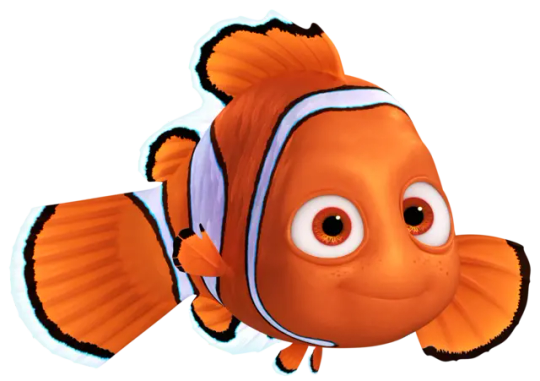
Clownfish (family Pomacentridae, subfamily Amphiprioninae) are fascinating creatures when it comes to gender — they exhibit sequential hermaphroditism, specifically protandry, which means all clownfish are born male, and some later change into females.
Clownfish live in small groups that are strictly hierarchical:
Dominant female at the top.
Dominant breeding male (her mate) is second.
Non-breeding subordinate males make up the rest of the group.
If the dominant female dies, the hierarchy shifts:
The dominant male changes sex to become the new female.
The largest subordinate male then becomes the breeding male.
This transformation involves physiological and hormonal changes, including the restructuring of gonadal tissue (the testis transforms into an ovary).
Once a male becomes female, the change is permanent. Clownfish cannot revert back to being male.
More about gender variation in the animal kingdom.
191 notes
·
View notes